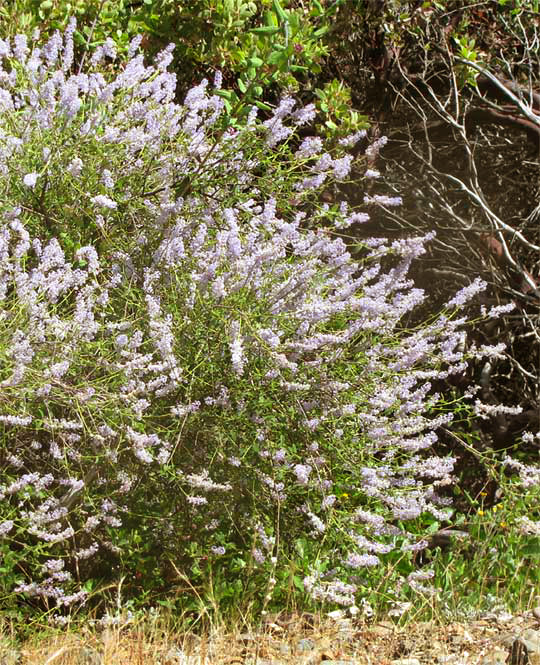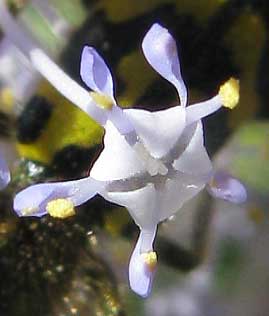Excerpts from Jim Conrad's
Naturalist Newsletter
from the June 7, 2009 Newsletter, issued from the Siskiyou Mountains west of Grants Pass, Oregon:
DEER BRUSH AT ITS PEAK
With regard to the Deer Brush mentioned above, week before last they didn't call attention to themselves at all but this week as I backpacked through the mountains they were the most conspicuously, abundantly and fragrantly flowering plant all along my route. That's one below:

Deer Brush is CEANOTHUS INTEGERRIMUS of the Buckthorn Family, the Rhamnaceae, and if this seems like a repeat from a recent Newsletter it's because in the May 17th Newsletter we had Buckbrush, Ceanothus cuneatus, a similarly prolifically flowering bush of the same genus. I don't like to repeat myself but I want to emphasize how important this genus is in this part of the world. California's Jepson Manual lists about forty for that state, and many are common, woody, substantial bushes.
One reason Ceanothus species abound here is that they are adapted for surviving fires. Long summer droughts are normal here and forest fires are frequent. One Ceanothus adaptation to fire is the production of large numbers of seeds that remain viable up to 24 years or more. Their dormancy is broken by seed coat scarification by fire or physical disturbance. Most of my hike last weekend passed through forest with tree trunks still blackened by a recent fire. Most Ceanothus species resprout from the root after the crown has burned.
Deer Brush helps burnt forests regenerate not only by stabilizing newly exposed soil with its roots but also by providing nitrogen created by its root association with nitrogen-fixing bacteria. Deer eat the plant and quail eat the seeds. Indigenous Californians used Deer Brush branches in treating women after childbirth; California's Miwok Indians further used the branches in making baskets.
 Flowers are white or blue. During my hike mostly I saw blue-flowered shrubs but white-flowered ones were common, and some plants displayed intermediate hues. Here and there the two forms mingled in equal numbers. I tried to make sense of the color variations but couldn't.
Flowers are white or blue. During my hike mostly I saw blue-flowered shrubs but white-flowered ones were common, and some plants displayed intermediate hues. Here and there the two forms mingled in equal numbers. I tried to make sense of the color variations but couldn't.
At the right one of Deer Brush's tiny flowers displays five stamens arising opposite five slender petals, typical of its family. This species' triangular sepals rise above and almost enclose the ovary. You might enjoy seeing how the above flowers' sepal configuration differs from that of our May-flowering species, still shown online here.